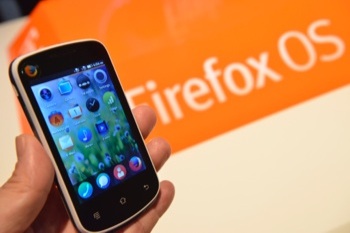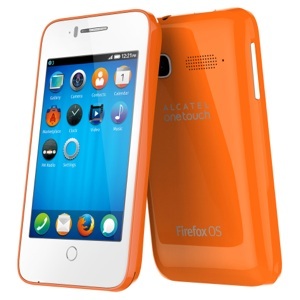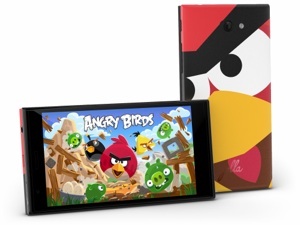Based on the latest IDC forecasts for a major slowdown in the smartphone market, mobile Linux contenders looking to get in on the smartphone-apalooza may find the glory days have gone. IDC projects smartphone shipments will grow 19.4 percent in 2014 — half the growth of last year’s 39.2 percent year-to-year rise – before dropping to 8.3 percent growth in 2017 and 6.2 percent in 2018.
Still, shipments will continue to grow, even if the pace falls off, and there are plenty of opportunities in smartphones, especially in budget devices.
 The new open source platforms can also find homes in faster growing categories like tablets, TV devices, and wearables. Samsung, for example, is postponing its Tizen smartphones for the time being in favor of applying the Linux-based OS to form-factors including cameras, refrigerator computers, and its stylish new Gear 2 smartwatches.
The new open source platforms can also find homes in faster growing categories like tablets, TV devices, and wearables. Samsung, for example, is postponing its Tizen smartphones for the time being in favor of applying the Linux-based OS to form-factors including cameras, refrigerator computers, and its stylish new Gear 2 smartwatches.
The coming smartphone slowdown certainly applies more pressure on mobile Linux platforms to either innovate with features or provide competitive pricing. Fortunately, examples of both were in evidence at this week’s Mobile World Congress (MWC), from Jolla’s modular faceplates to a $25 Firefox OS smartphone prototype.
IDC and others agree that budget smartphones will dominate future smartphone shipments, as emerging-market consumers switch from feature phones or no phone at all. The 2013 average selling price (ASP) will likely drop from $335 to $260 by 2018, says IDC. Indeed, MWC was awash in budget phones. For every high-end, octa-core phablet or Samsung Galaxy S 5, there were several new budget models, almost all running Android.
Even Microsoft’s Nokia went lower end with new X and X+ phones running a modified Android build and selling for just 89 and 99 euros, respectively. The irony works on many levels here, including the fact that before Nokia went high-end with Windows Phone, it dominated feature phone sales. Nokia phones are still the most commonly seen phones in developing nations.
Spreadtrum’s $25 Firefox OS phone
Perhaps the most significant announcement at MWC came from Mozilla and Spreadtrum, which showed a prototype of a Firefox OS phone that will sell for $25. The prototype is the cheapest of several 3G and 2G budget Firefox OS reference designs from China-based Spreadtrum, which is incorporating its new 1GHz Cortex-A5 based SC6821 chipset. Like most current Firefox OS phones, the designs are limited to 3.5-inch devices, but there’s a full suite of wireless features, and a 5-megapixel camera.
Already, Indonesian carriers Telkomsel and Indosat say they’ll launch the $25 phones later this year, and Telenor has also shown interest. By comparison, the cheapest Android phones tend to go for about $50. Although Google has tweaked Android 4.4 to run on lower-end devices, Firefox OS appears to run better on low-end silicon, thanks in large part to its lightweight HTML5 architecture.
 Mozilla had the most smartphone news among the mobile Linux contenders. The company launched a self-branded Flame developer phone, as well as 10.1-inch InFocus and 7-inch Vixen developer tablets from Foxconn and Via Technologies, respectively.
Mozilla had the most smartphone news among the mobile Linux contenders. The company launched a self-branded Flame developer phone, as well as 10.1-inch InFocus and 7-inch Vixen developer tablets from Foxconn and Via Technologies, respectively.
ZTE and Alcatel announced more Firefox OS devices, including the ZTE Open C and Open II, and the Alcatel OneTouch Fire C, E, and S phones. Alcatel also unveiled the first commercial Firefox OS tablet — the Alcatel One Touch Fire 7— and Huawei showed off its Y300 phone.
Most of these devices offer much loftier specs than the first round of low-cost ZTE and Alcatel phones, or even LG’s Fireweb. However, they’re still barely mid-range at most, which is right where Mozilla and its partners want them.
The Alcatel Fire S, for example, sports a 1.2GHz, quad-core processor, and a 4.5-inch, 960 x 540-pixel IPS screen, as well as 4G LT, NFC, and 8- and 2-megapixel cameras. Alcatel’s Fire 7 features a dual-core, 1.2 GHz processor and a 7-inch 960 x 540 display, yet sells for only 79 euros.
The ZTE Open C is more modest, but still advances to a dual-core 1.2GHz CPU and a 4-inch display. Huawei’s Y300 is a rebadge of an existing Android phone, and offers a 4-inch WVGA display and a dual-core processor.
Mozilla says it sold between 500,000 and 750,000 Firefox OS phones in its first six months, and that it will expand this year from 15 markets to 27. Other Firefox OS announcements include new App Manager development tools and PhoneGap support.
Jolla focuses on innovation
Jolla and Ubuntu also had news about their mobile Linux platforms. Jolla recently began selling its Sailfish OS phones throughout Europe, and this week released Sailfish OS 1.0. This first formal release of the MeeGo Linux-based OS offers performance and battery improvements, plus enhancements to landscape mode and camera zoom.
The Finnish company also tipped a UI launcher due in the second quarter, designed to simulate the Sailfish OS gesture interface on Android devices. The idea is that Android users will fall for the novel UI, and load up Sailfish OS on selected Android phones as the builds mature later in the year.
 The current Jolla phone is too pricey for emerging markets, so Jolla is instead promoting innovations like Android compatibility, as well as its customizable The Other Half backplates. At MWC, Jolla announced custom The Other Half covers for Rovio’s Angry Birds and clothing retailer Makia.
The current Jolla phone is too pricey for emerging markets, so Jolla is instead promoting innovations like Android compatibility, as well as its customizable The Other Half backplates. At MWC, Jolla announced custom The Other Half covers for Rovio’s Angry Birds and clothing retailer Makia.
Google is pursuing an even more radical modular smartphone vision with Project Ara. According to a Feb. 26 report in Time, Google announced an Ara Developers’ Conference on April 15-16 in Mountain View. Countering the critique that such a modular phone would be overpriced, Google is planning to ship the core exoskeleton for $50.
Canonical tips first Ubuntu Phone manufacturers
Finally, Canonical announced its first two hardware partners for Ubuntu Phone. Belying earlier suggestions that the first Ubuntu Phones might slip to 2015, Meizu and BQ claim they’ll ship by the end of the year.
Judging from the high-end Meizu and BQ phones shown at MWC, Ubuntu will also initially focus more on innovation than low price. Meizu will load Ubuntu on its existing MX3, which runs Meizu’s own Flyme Android derivative on a Samsung Exynos Octo processor, and offers a 5.1-inch 1800 x 1080-pixel display. The prototype from Spain’s BQ has a quad-core processor.
Going high end makes sense for Ubuntu Phone, which is perhaps the most innovative of all the emerging platforms, as it offers seamless links with Ubuntu desktops, using essentially the same desktop Linux OS. Ubuntu’s best chance of success may well be on tablets, which don’t appear to face the same slowdown as smartphones.
IDC: Smartphone slowdown coming, but Linux to grow fastest
Despite smartphone volume in 2013 that for the first time surpassed 1 billion units, the smartphone market is heading for a major slowdown, according to a Feb. 26 report form IDC. It’s not that the party is over — IDC projects the market will grow 19.4 percent in 2014 — but that’s almost half the growth of last year’s 39.2 percent year-to-year rise. Saturated markets in North America and Europe will lead the continuing slowdown to 8.3 percent annual growth in 2017 and 6.2 percent in 2018, projects IDC.
According to IDC, Android will garner 78.9 percent of smartphone shipments in 2014, dipping to 76 percent by 2018. Apple will also drop slightly from 14.9 percent to 14.4 percent, says IDC. While Android ASPs will drop 6.1 percent through 2018, iPhone pricing is expected to dip only 1.2 percent, projects IDC.
IDC projects a larger 8.3 percent ASP drop for Windows Phone through 2018, along with a corresponding shipment increase of 29.5 percent, boosting it to 7 percent share. It should be noted, however, that IDC has been more bullish on Windows Phone than have most prognosticators, and Microsoft’s OS has yet to prove it can work well on low-end devices.
The fastest growing OS category through 2018 will not be Windows Phone, says IDC, but “Other,” which will grow 32.7 percent to a 2.3 percent share. These days “Other” means mobile Linux vendors. Judging from a recent IDC projection for yearly growth in Firefox OS smartphone volumes by a factor of six, Mozilla’s OS should dominate “Other” stats at least in the early years.
A total of 2.3 percent may not seem like much, but it’s better than Blackberry’s projected 0.3 percent. Booyah!


